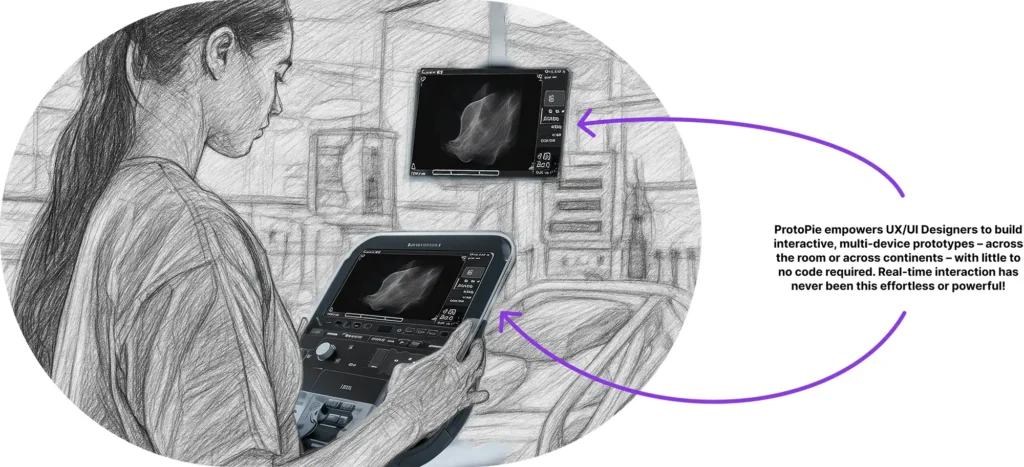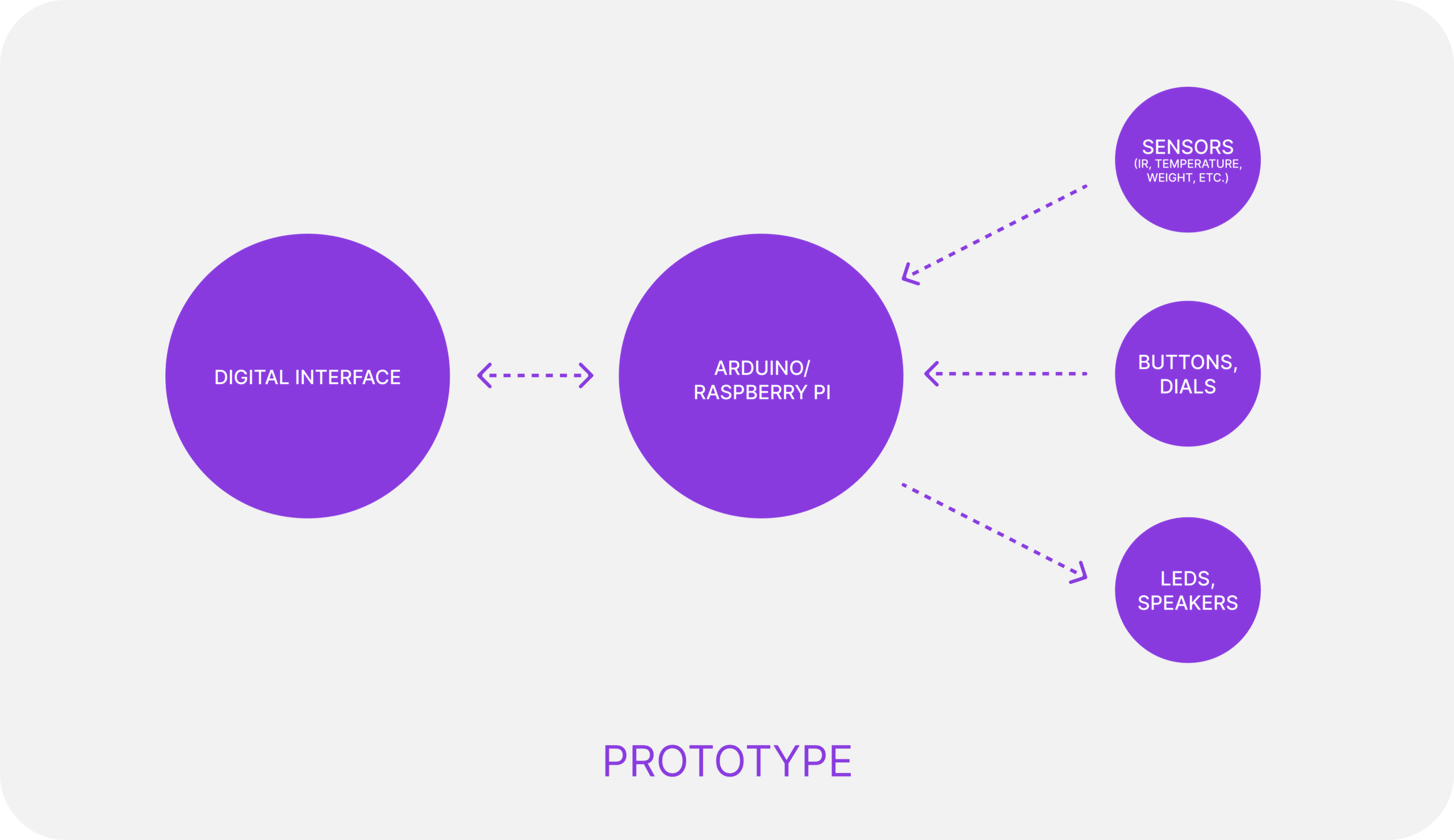
Touch It to Believe It: Cost-Efficient, Tangible Prototypes That Impress Users, Boards and Investors.
Bridging Digital Interfaces with Physical Interactions for Usability Evaluation, Storytelling, and Stakeholder Buy-in.
In the complex world of medical device development, creating effective prototypes is more than just a creative exercise, it’s a regulatory necessity and a strategic imperative. Design and usability testing must meet not only technical standards but also satisfy clinical expectations, regulatory scrutiny, and executive stakeholders.
Traditionally, high-fidelity, interactive prototypes—especially those that mimic both digital and physical elements—have required substantial investment in software development, hardware fabrication, and systems integration. But tools like Figma and ProtoPie are transforming the prototyping landscape, especially when paired with affordable physical computing platforms like Arduino or Raspberry Pi.
This article explores how ProtoPie enables Design teams to create cost-efficient, high-fidelity prototypes that simulate real-world medical device interactions. These prototypes are not only useful for usability testing, but also serve as strategic tools for investor presentations, board meetings, and internal project pitches.
The Challenge: Bridging the Gap Between Screen and Skin
Medical devices are inherently multi-modal. While much of the UX/UI design effort is focused on digital interfaces—touchscreens, dashboards, app controls—the devices themselves often include tangible elements such as physical buttons, sliders, rotary knobs, LED indicators, haptic feedback, audio cues.
Traditionally, demonstrating these interactions meant choosing between extremes: building fully coded prototypes that were expensive and time-consuming, cobbling together low-fidelity mockups with limited interactivity, or presenting disconnected digital and physical elements that failed to convey the full experience. The result? Limited insight during usability testing and poor emotional engagement during stakeholder presentations.
ProtoPie: A New Era in Multi-Sensory Prototyping
ProtoPie is a powerful tool for building interactive, high-fidelity prototypes with little to no code. Initially known for enabling micro-interactions like gestures, animations, conditionals, it has since evolved to support hardware integration through its ProtoPie Connect platform.
ProtoPie Connect allows UX/UI Designers to integrate digital mockups with real-world components, including sensors, buttons, rotary encoders, LED indicators, haptic actuators, and even smartphone features like voice recognition or GPS. These connections make it possible to simulate realistic device behavior. When a user presses a physical button, the screen responds. When a threshold is reached, the LED turns red. When a measurement is complete, a haptic buzz or audio chime provides feedback. All of it is controlled by ProtoPie.

From Figma to Functional Interactive Demo
ProtoPie enables design teams to simulate real-world interactions without writing code. The following workflow shows how digital screens, conditional logic, and physical components can come together into a fully interactive prototype.
1. Design the Interface in Figma
Although ProtoPie allows you to create your interface in it, it is still easier and faster designing the digital interface in Figma, including all key screens, buttons, alerts, and state transitions your device may display. Build with components where possible to maintain consistency and screen logic across flows.
2. Import the interface into ProtoPie
Use ProtoPie’s direct Figma integration to import your designs. This process preserves your screens, design components, and layer hierarchy, allowing you to continue working with interactivity and structure intact. There’s no need to rebuild layouts from scratch.
3. Build Interaction Logic
Use ProtoPie’s visual logic builder to define behavior. For example, trigger an alert when a temperature sensor exceeds 38.5°C, link rotary input to dosage values, or dim the screen after inactivity. These interactions are created without code, using conditionals and transitions.
4. Add Physical components with ProtoPie Connect
Pair your prototype with a physical computing platform such as Arduino or Raspberry Pi. ProtoPie Connect lets you wire in physical components like buttons, dials, sensors (e.g. IR, temperature, weight, etc.), speakers or LED strips and link them directly to interface logic. This makes it possible to test real-world interaction scenarios with little to no embedded code. Once completed, this can be mounted in a physical prototype created by the Industrial Designers.
5. Run and test your prototype
The result is a prototype that behaves like the real product, combining digital and physical inputs and outputs. Teams can use it for usability testing, design validation, and stakeholder demonstrations. Because it requires no custom firmware, iteration cycles are faster and easier to manage.

ProtoPie’s Impact on UX/UI Design
One of the most valuable contributions is how it empowers UX/UI Designers to take creative control over the user interaction prototyping process and uncover insights that static wireframes or mockups can’t deliver.
Turning Ideas into Tangible Experiences
UX/UI Designers often imagine user interactions that extend beyond the screen: how a screen reacts to a physical input, how a device behaves when tilted or touched, or how feedback is delivered through light or sound. ProtoPie allows them to realize these ideas in working form, transforming abstract concepts into concrete, testable experiences.
Revealing Hidden Design Challenges
Many usability issues only surface once a concept becomes interactive. ProtoPie gives UX/UI Designers a platform to experiment with flows, transitions, and feedback mechanisms in real-time, catching flaws that static mockups hide. These may include overwhelming or unclear alert sequences, mismatched timing between user actions and system responses, or inadequate feedback for critical events like dosage confirmation. By prototyping these behaviors early, designers can validate assumptions and refine solutions before development begins, saving time, budget, and engineering effort.
Bridging Communication Gaps with Developers
ProtoPie’s interactive logic and conditional modeling help UX/UI Designers express behavior clearly to development teams. Instead of writing long specifications or handing off flat screens, they can share working prototypes that demonstrate interaction flows exactly as intended. This improves collaboration and reduces ambiguity during development hand-off.
Why This Matters for Medical Device Development
Realistic Usability Testing
Medical devices are used in high-stakes, often stressful environments. Emergency rooms, ICUs, and ambulatory clinics all demand intuitive, reliable interaction. Usability testing must reflect these conditions.
ProtoPie-powered prototypes give clinicians, patients, and caregivers the opportunity to interact with a close-to-final experience.
This leads to higher quality feedback and helps identify issues early, such as:
- Poor button placement for gloved users
- Inconsistent or unclear visual, audio, or haptic feedback
- Sensor lag that affects perceived performance
Regulatory and ISO Compliance
Standards like IEC 62366 and ISO 9241 emphasize the importance of early-stage usability validation. ProtoPie’s fidelity makes it possible to gather meaningful qualitative and quantitative data during the formative testing phases, without needing a full software build.
Faster Iteration Without Engineering Bottlenecks
Engineering resources are often overextended. ProtoPie allows design and human factors teams to prototype and test independently, so insights from usability testing can be incorporated quickly and much earlier in the development process.
Beyond Testing: A Tool for Strategic Storytelling
If you’re a medical startup founder, you know that winning over investors depends on how convincingly you present your concept. A live, interactive prototype that looks and feels like the real product can demonstrate exactly why your concept is worth backing:
- Credibility — You’ve gone beyond static design and shown proof of function
- Excitement — Investors can physically interact with your concept
- Flexibility — You can adapt the experience for different pitch scenarios
Unlike slide decks or animations, a ProtoPie prototype makes the product feel real, even at the seed stage. That can be the difference between a polite no and a firm yes.
For entrepreneurs working within larger Medtech companies, earning internal buy-in from executives or boards can be just as challenging.
A working prototype in the boardroom, where directors can adjust a dial, feel a haptic pulse, or view real-time feedback highlights the qualities that help stakeholders move forward with confidence:
- Tangibility — The idea has been de-risked through simulation
- Clarity — Stakeholders know exactly what they’re being asked to support
- Momentum — The team is already building, testing, and learning
In this context, ProtoPie becomes a persuasion tool as much as a design tool.
Cost Efficiency: Lower Risk, Faster Returns
Unlike traditional prototyping paths (e.g., building functional UIs in embedded C++ or development or mobile app frameworks, ProtoPie offers a faster, more flexible path:
- Low-code – Allows UX/UI Designers to build and test prototypes without relying on engineering resources.
- Reusable – Logic, assets, and hardware components can be repurposed across multiple iterations.
- Modular – Physical components can be swapped in or out to support evolving interface needs.
- Scalable – Prototypes can be tested remotely through ProtoPie Player or Connect, enabling collaboration across distributed teams.
This leads to massive time and cost savings, particularly in early development stages where pivots are common.
Conclusion: Design, Test, and Persuade with One Tool
ProtoPie sits at the intersection of digital interaction design and physical product development, making it uniquely suited for modern medical device innovation. Whether you’re validating a clinical workflow, preparing for a regulatory submission, or pitching to a room full of investors, the ability to create high-fidelity, emotionally engaging prototypes with minimal cost is a game-changer.
For UX/UI designers, ProtoPie opens the door to rapid experimentation, early validation, and creative control. It helps transform ideas into tangible, testable experiences revealing issues that would otherwise remain hidden until too late.
By combining Figma interfaces with real-world inputs and outputs through ProtoPie and low-cost hardware, teams can move faster, reduce development risk, and tell better stories.
In a world where demonstrating value is just as important as delivering function, ProtoPie might just be your most valuable development partner.
TL;DR
- ProtoPie bridges digital and physical by connecting Figma-based UI designs with real hardware components like sensors, haptics, and lights.
- No production code required, allowing UX/UI Designers to simulate realistic device behavior early in development.
- Improves usability testing by supporting IEC 62366-aligned validation with high-fidelity, interactive prototypes.
- Strengthens stakeholder engagement by providing live, interactive demos for investors, executives, and clinicians.
- Reduces cost and iteration cycles by enabling design teams to work independently of engineering resources.
Rodolfo Prata is a Senior UX Designer at StarFish Medical. Rodolfo studied Multimedia Design at Senac University (São Paulo, Brazil) and User Experience (UX) Design at the University of Toronto. Rodolfo is highly passionate about UX Design, always seeking innovative ways to improve user interactions for devices and services.
Videos: ProtoPie.io
Images: StarFish Medical
Related Resources

In MedTech, success rarely comes from invention alone. Plenty of promising technologies make it through verification and early clinical work, only to stall when the team tries to turn them into something buildable.

From how much of your body is actually bacterial to how fast microbes can multiply, these facts are designed to stick with you long after the party ends.

In medical device development, verification is both a safeguard and a stress test, not just for the product, but for the process.
